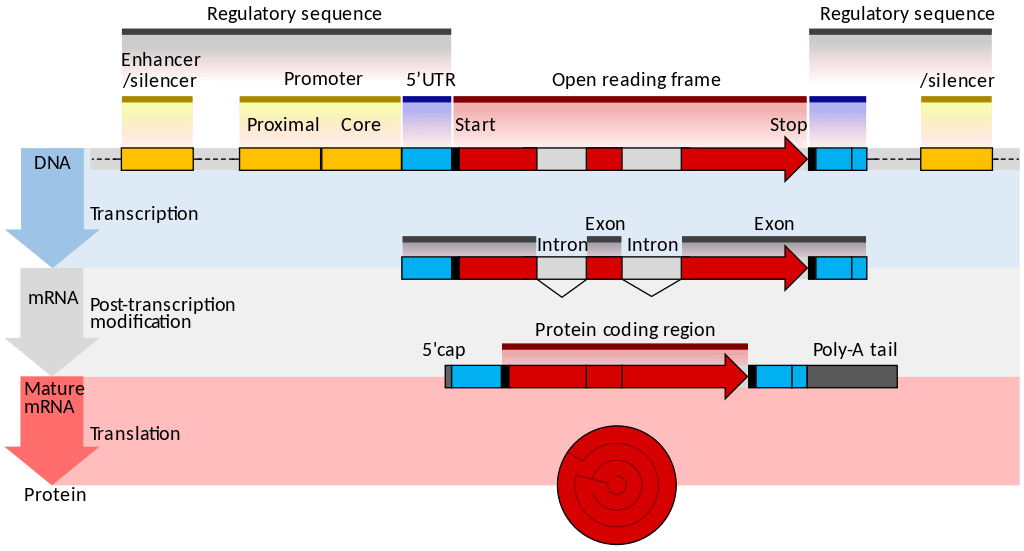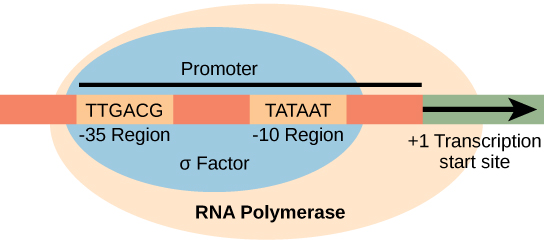Difference Between Eukaryotic and Prokaryotic Promoters
Key Difference – Eukaryotic vs Prokaryotic Promoters
Transcription is the process of converting the genetic information stored in the coding DNA sequence into mRNA sequence. A specific region of DNA located at the 5’ end of the transcriptional unit initiates this process. That region is known as the promoter region. These promoters are typically found adjacent to the transcription start site. The length of a promoter varies from 100 bp to 1000 bp. Promoters are different according to the type organism. Eukaryotic and prokaryotic promoters are different from each other. In prokaryotes, only three types of promoter sequences are found namely, -10 promoters, -35 promoter and upstream elements. In eukaryotes, there are many different promoter elements such as TATA box, initiator elements, GC box, CAAT box, etc. This is the key difference between eukaryotic and prokaryotic promoters.
CONTENTS
1. Overview and Key Difference
2. What are Eukaryotic Promoters
3. What are Prokaryotic Promoters
4. Similarities Between Eukaryotic and Prokaryotic Promoters
5. Side by Side Comparison – Eukaryotic vs Prokaryotic Promoters in Tabular Form
6. Summary
Three main portions; core promoter, proximal promoter and distal promoter, collectively form a promoter. In the context of eukaryotes, there are many numbers of promoter elements are found that are highly sophisticated and more diverse than promoters. It has been found out that, due to this complexity of the eukaryotic promoters, the DNA has the capability to fold back on itself. This also explains the fact that, the effect of many regulatory sequences take place even though they are located many kilobases away from the site of transcription. These eukaryotic promoters have the ability to span through a wide range of DNA sequences.

Figure 01: Eukaryotic Promoter
Examples for some eukaryotic promoters are Pribnow box (TATA box), GC box, CAAT box etc. In the context of TATA box, it is a sequence of 5’ – TATAA -3’ that is present in the core promoter region. To the TATA box, transcription factor proteins and histone proteins are bound. The binding of transcription factor proteins to the TATA box assists in the binding of RNA polymerase, which then results in the formation of transcription complex. In simple terms, the binding of these proteins will drive the process of transcription. This process will be inhibited when histone proteins get bound to the TATA box. Therefore, the TATA box is an important promoter element that involves in regulation of the rate of eukaryotic transcription.
In prokaryotic organisms, the promoter that involves in transcription is identified by the associated factor called sigma factor. Sigma factors are unique to different promoter sequences. Therefore, it is said that each single sigma factor would recognize a single core promoter sequence. This is a unique characteristic that is present in the prokaryotic transcription process. Both RNA polymerase and the sigma factor collectively identify the correct promoter region and form the transcription complex.
The prokaryotic promoter contains only three types of promoter elements. The less involvement of promoter elements in prokaryotes is the main reason why their transcription process is less sophisticated when compared with eukaryotic transcription that involves a higher number of promoter sequences. Out of the three promoter elements of prokaryotes, there are two main important two short DNA sequences. These sequences are classified according to their location. They are, -10 promoters or element (that is present 10bp upstream of transcription start site), -35 promoters or element (that is present 35bp upstream of transcription start site).

Figure 02: Prokaryotic Promoter
The -10 promoter is equivalent to the eukaryotic TATA box or Pribnow box and is an essential component for the initiation of transcription in prokaryotes. The -35 promoter consists of a sequence that is TTGACA that actively involves in the regulation of the rate of prokaryotic transcription.
- In both types, the promoters are controlled by different DNA regulatory sequences that include enhancers, silencers, insulators and boundary elements.
- Promoters are the sequences that initiate transcription in prokaryotes and eukaryotes.
- Promoters are DNA sequences.
Eukaryotic vs Prokaryotic Promoters | |
| Eukaryotic promoters are the regulatory sequences that initiate the transcription of eukaryotic organisms. | Prokaryotic promoters are the regulatory sequences that initiates the transcription of prokaryotic genes. |
| Elements | |
| Prokaryotic promoter consists of upstream elements, -10 element and -35 elements. | Eukaryotic promoter consists of Pribnow box (TATA box), CAAT box, GC box and initiator elements. |
Summary – Eukaryotic vs Prokaryotic Promoters
A promoter is a region of DNA that involves the initiation of the process called transcription. These promoters are typically found upstream to the transcription start site. The three main portions that form a promoter are core promoter, proximal promoter and distal promoter. In the context of eukaryotes, there are many numbers of promoting elements in the promoter region that are highly sophisticated and more diverse than prokaryotes. Examples of some eukaryotic promoter elements are Pribnow box (TATA box), GC box, CAAT box etc. In prokaryotes, there are two main important promoter elements namely -10 element (that is present 10bp upstream of transcription start site), -35 elements (that is present 35bp upstream of transcription start site). -10 promoter initiates the transcription, and the -35 promoter regulates transcription. Both types of promoters are controlled by different DNA regulatory sequences that include enhancers, silencers, insulators and boundary elements. This is the difference between eukaryotic and prokaryotic promoters.
Download the PDF of Eukaryotic vs Prokaryotic Promoters
You can download the PDF version of this article and use it for offline purposes as per citation note. Please download the PDF version here: Difference Between Eukaryotic and Prokaryotic promoter
Reference:
1.Kanhere, A. “Structural properties of promoters: similarities and differences between prokaryotes and eukaryotes.” Nucleic Acids Research, vol. 33, no. 10, Feb. 2005, pp. 3165–3175., doi:10.1093/nar/gki627.
2.“Promoters.” Addgene. Available here
Image Courtesy:
1.’Gene structure eukaryote 2 annotated’ By Thomas Shafee – Shafee T, Lowe R (2017). “Eukaryotic and prokaryotic gene structure”. WikiJournal of Medicine 4 (1). DOI:10.15347/wjm/2017.002. ISSN 20024436., (CC BY 4.0) via Commons Wikimedia
2.’Figure 15 02 01′ By CNX OpenStax, (CC BY 4.0) via Commons Wikimedia
ncG1vNJzZmivp6x7pbXFn5yrnZ6YsqOx07CcnqZemLyue8OinZ%2Bdopq7pLGMm5ytr5Wau26x1KSYq7GfqbakecCnm2auo2K9s7vKmqmyp6SesG680aikqKyVp8Bw